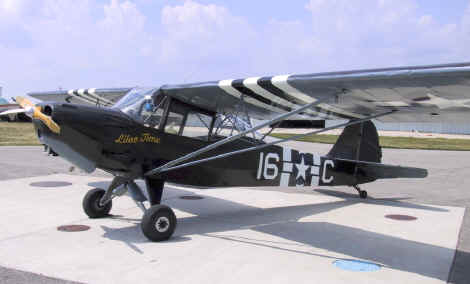|

1944 L-2 Grasshopper N50113, s/n 5463,
owned and flown by Charles Gries, Poplar Grove Airport, Illinois, USA.
Photo by Buck Wyndham.
History: Following an aerial observation
tradition more than 200 years old, the Taylorcraft Model D tandem trainer was
"drafted" in 1941 for artillery spotting, light transport and courier service.
After the U.S. Army successfully evaluated examples of the aircraft under the designation YO-57
for use in artillery spotting and liaison, 70 were ordered as the O-57
Grasshopper, powered by a 65hp Continental O-170-3 engine. That order was followed by a
modification that added a radio and improved the all-around view with additional glazing
to the cockpit area. 336 of that variant, designated O-57A, were
ordered.
When American troops went into combat in WWII, the Army Air Force used the O-57/-57A for
directing artillery fire on enemy troop and materiel concentrations, much as observation
balloons had been used in W.W.I. The O-57, being far more mobile than earlier hot air and
gas balloons, was also used for other types of liaison and transport duties, its ability
to land and takeoff from small unprepared landing strips making it an ideal front-line
vehicle.
140 of the O-57As were ordered in 1942, at which time the two variants were re-designated L-2
and L-2A, respectively.
Subsequent modifications yielded 490 L-2Bs aircraft produced especially for field
artillery spotting and a variant with wing spoilers and a completely cowled engine, the L-2M,
of which 900 were ordered. Various civilian models of Taylorcraft, in small quantities,
were "drafted" into military service with designations from L-2C
through L-2L.
253 engineless gliders based on the L-2 design were also
manufactured by Taylorcraft for use as glider trainers. Designated ST-100,
they were used primarily by the U. S. Army to train glider pilots for combat insertions,
often behind enemy lines (as, for example, in the Normandy landings).
While some L-2s were furnished to foreign air forces, many were "mustered
out," to rejoin their civilian counterparts on the U.S. civilian register after the
war as comparatively cheap "warbirds." In the immediate postwar era, the
commercial BC-12 D was manufactured for a time, and has become a popular example of
late-1940's light aircraft.
While the observation tradition today is more likely to be carried on by pilotless
aircraft, or the even more exotic "Micro Air Vehicles" being experimented with
in numerous high-tech research facilities, the various species of "Grasshoppers"
used by the United States in WWII will always occupy a special niche in the lore of
aviation.
Nicknames:
Grasshopper
Specifications:
Engine: One 65-hp Continental O-170-3 flat-four piston engine
Weight: Empty 875 lbs., Max Takeoff
1,300 lbs.
Wing Span: 35ft. 5in.
Length: 22ft. 9in.
Height: 8ft. 0in.
Performance:
Maximum Speed:
102 mph
Ceiling: 16,000
ft.
Range: 230 miles
Armament: None
Number Built: 1,726+
Number Still Airworthy: 150+
Links:
International
Liaison Pilots and Aircraft Ass'n (ILPA)
Taylorcraft Foundation
Taylorcraft
Foundation Discussion Forums
USAF
Museum L-2 Page
Books: Browse a
selection of books about liaison aircraft.

[Back to Warbird Alley's Main
Page]
All text and photos Copyright 2016 The
Doublestar Group, unless otherwise noted.
You may use this page for your own, non-commercial reference purposes only.
 |